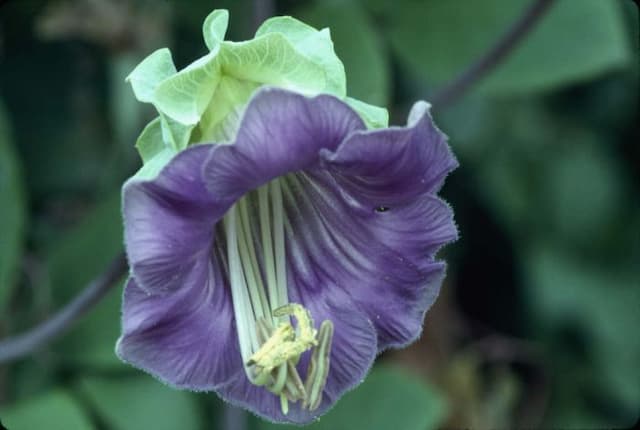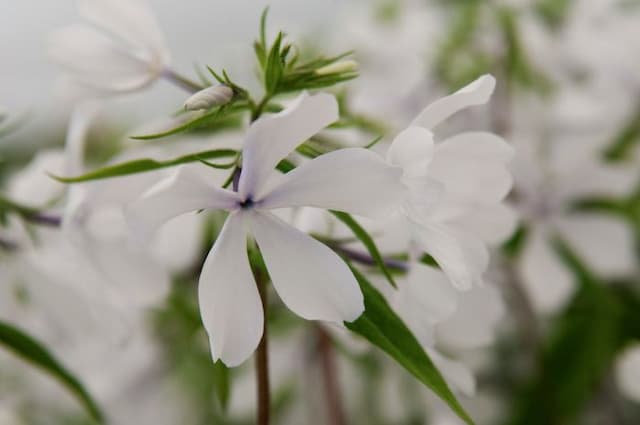Longleaf phlox Phlox longifolia subsp. brevifolia

ABOUT
The plant, commonly known as Longleaf Phlox, typically exhibits a dense, mat-forming growth habit, creating clusters of foliage close to the ground. Its leaves are narrow and needle-like, with a strong green color, and they often remain relatively small. The plant's leaves are sometimes hairy or sticky, giving them a textured feel. During its blooming period, Longleaf Phlox produces a profusion of flowers. These blossoms are carried in clusters on top of short, upright stems that rise from the mat of foliage. The flowers can vary in color, commonly displaying shades of pink, purple, or white, each with a small, tubular shape that flares open into five distinct, rounded lobes. In the center of each flower, there's typically a darker eye or a more vividly patterned center that adds contrast to the blooms. The roots are fibrous and may form a tight network beneath the plant, helping it to anchor in the soil and spread. Its overall appearance is one of dense greenery punctuated by abundant, colorful flowers which can add a splash of color to a garden setting.
About this plant
 Names
NamesFamily
Polemoniaceae
Synonyms
Longleaf Phlox, Brevifolia Phlox
Common names
Phlox longifolia var. brevifolia, Phlox brevifolia.
 Toxicity
ToxicityTo humans
There is limited information on the specific subspecies Phlox longifolia subsp. brevifolia. However, for the genus Phlox to which it belongs, there are no well-documented cases of severe toxicity to humans. In general, Phlox species, commonly known as longleaf phlox, are not considered highly toxic to humans. Nevertheless, ingestion of any plant material can potentially cause gastrointestinal upset, such as nausea, vomiting, or diarrhea in some individuals due to the presence of saponins and other plant compounds. If any part of the plant is ingested and symptoms occur, it is advisable to consult a healthcare professional.
To pets
There is limited information on the specific subspecies Phlox longifolia subsp. brevifolia regarding its toxicity to pets. Plants in the Phlox genus, commonly referred to as longleaf phlox, are generally not considered highly toxic to animals. Ingestion of plant parts by pets may cause mild gastrointestinal discomfort, which could include symptoms like vomiting and diarrhea. Since pets can react differently to various plants, if a pet ingests any part of this plant and shows signs of distress, it is important to contact a veterinarian.
 Characteristics
CharacteristicsLife cycle
Perennials
Foliage type
Deciduous
Color of leaves
Green
Flower color
Pink
Height
1-2 feet (30-60 cm)
Spread
1-2 feet (30-60 cm)
Plant type
Herb
Hardiness zones
5
Native area
North America
Benefits
 General Benefits
General Benefits- Aesthetic appeal: Long-leaf phlox adds color and beauty to gardens and landscapes with its showy flowers, typically ranging from pale lavender to blue-violet.
- Pollinator attraction: The plant is known for attracting butterflies, bees, and other pollinators, which are essential for the pollination of many other plants.
- Drought resistance: As a plant adapted to dry conditions, long-leaf phlox can thrive in areas with low water availability, making it suitable for xeriscaping.
- Easy propagation: This subspecies of phlox can be easily propagated through division or cuttings, allowing gardeners to multiply their plants without much effort.
- Wildlife habitat: Provides cover and nectar for a variety of wildlife, enhancing biodiversity in the area where it is planted.
- Low maintenance: Long-leaf phlox generally requires minimal care once established, being tolerant to various soil types and conditions.
- Seasonal interest: It offers visual interest throughout its blooming season in late spring to early summer, contributing to the seasonal dynamics of a garden.
 Medical Properties
Medical Properties- This plant is not used for medical purposes.
 Air-purifying Qualities
Air-purifying QualitiesThis plant is not specifically known for air purifying qualities.
 Other Uses
Other Uses- Phlox longifolia subsp. brevifolia can be used as a colorful ground cover in landscaping due to its mat-forming habit.
- The flowers are attractive to butterflies and can be planted to create a butterfly garden.
- This plant is suitable for rock gardens because of its preference for well-drained soils and its low-growing nature.
- The blooms can add visual interest to wildflower meadows as they integrate well with other native species.
- Phlox longifolia can serve as an indicator of ecosystem health, as it thrives in undisturbed habitats.
- The flowers can be used in casual floral arrangements for a natural, wildflower look.
- Due to its drought tolerance, it can be included in xeriscaping, which conserves water in landscaping.
- The seeds can be collected and used to propagate more plants for restoration or conservation projects.
- Dried phlox can be used in potpourri mixes to add fragrance and color.
- In educational settings, the plant can be used to teach students about native plant species and their role in supporting local wildlife.
Interesting Facts
 Feng Shui
Feng ShuiThe plant Phlox is not used in Feng Shui practice.
 Zodiac Sign Compitability
Zodiac Sign CompitabilityThe plant Phlox is not used in astrology practice.
 Plant Symbolism
Plant Symbolism- Harmony: The phlox, with its growth habit of clustering in groups, signifies harmonious blending, representing unity and compatible relationships.
- Agreement: The way phlox blooms with flowers that seem to agree with each other on their stalks symbolizes consensus or general agreement in a group.
- Proposal: In Victorian floral language, phlox would often be used to propose unity and harmony, signaling a proposition for partnership or even marriage.
- Sweet Dreams: Phlox is also said to symbolize sweet dreams, as the clusters of flowers can be reminiscent of the calming and pleasant thoughts that lead to a peaceful sleep.
 Water
WaterFor Phlox longifolia subsp. brevifolia, commonly known as Longleaf Phlox, it’s important to maintain consistent moisture but avoid overwatering. During the growing season, water the plant once a week with approximately one gallon of water, making sure it penetrates the soil deeply to encourage strong root development. The amount of water may need to be adjusted depending on climate conditions; during hot, dry periods, additional water may be necessary. Reduce watering in the fall and winter when the plant is dormant. Ensure good drainage to prevent root rot, as this species can be susceptible to excessive moisture.
 Light
LightLongleaf Phlox thrives best in full sun to partial shade conditions. The ideal spot for this plant is an area that receives at least 6 hours of direct sunlight per day but is sheltered from the harshest midday sun. It can tolerate some light afternoon shade, especially in hotter climates, which can help protect the plant from excessive heat stress.
 Temperature
TemperatureLongleaf Phlox is hardy and can tolerate a range of temperatures, but it prefers mild to warm conditions. The ideal temperature range for this plant is between 60 and 85 degrees Fahrenheit. It can survive minimum temperatures down to 20 degrees Fahrenheit but sustained frost or extreme heat can damage or kill the plant. During the growing season, keep temperatures within the ideal range to encourage robust growth and flowering.
 Pruning
PruningLongleaf Phlox benefits from pruning to promote bushier growth, enhance flowering, and prevent disease. Prune in early spring by cutting back the plant by about one-third to stimulate new growth. Deadheading, or removing spent flowers, throughout the flowering season also encourages more blooms and prevents self-seeding. After blooming has finished, prune the plant back to maintain its shape and size. The best time for major pruning is early spring or immediately after the flowering period.
 Cleaning
CleaningAs needed
 Soil
SoilLong-leaf phlox thrives in well-draining soil with a neutral to slightly alkaline pH between 6.5 and 7.5. A mix of garden soil, compost, and coarse sand or perlite can promote good drainage and fertility. Ensure the soil is rich in organic matter to support its growth.
 Repotting
RepottingLong-leaf phlox generally does not require frequent repotting and can be repotted every 2 to 3 years. It is best to repot in the spring, just before the onset of the growing season, allowing the plant to establish in its new container.
 Humidity & Misting
Humidity & MistingLong-leaf phlox prefers moderate humidity levels but is quite adaptable and can tolerate the varying humidity conditions typical of many outdoor environments. It does not have specific high humidity requirements.
 Suitable locations
Suitable locationsIndoor
Ensure bright light, cool temperatures, and good airflow for indoor long-leaf phlox.
Outdoor
Plant in well-draining soil, full sun to partial shade, and water regularly.
Hardiness zone
4-8 USDA
 Life cycle
Life cyclePhlox longifolia subsp. brevifolia, commonly known as the Longleaf Phlox, typically begins its life cycle as a seed, which germinates in the suitable environmental conditions of late fall to early spring. After germination, the seedling emerges and develops into a rosette of leaves close to the ground during its initial growth stage. As the plant matures, it starts to elongate its stems, leaves become more developed, and it enters the vegetative growth phase. The flowering stage occurs next, usually in late spring to early summer, where the plant produces clusters of tubular, fragrant flowers that can be pink, purple, or white. After pollination by insects, the flowers develop into fruit capsules that contain small seeds, which are subsequently dispersed by wind, water, or animals. Finally, the Longleaf Phlox enters a period of dormancy in late fall or early winter where it may die back to the ground, with the roots or basal rosette surviving until the next growing season.
 Propogation
PropogationPropogation time
Spring
Propogation: The most popular method of propagating the Narrowleaf phlox, Phlox longifolia subsp. brevifolia, is through cuttings. Cuttings are typically taken in late spring or early summer when the plant is actively growing. A cutting of about 4 to 6 inches (approximately 10 to 15 centimeters) is snipped just below a node, which is the point on the stem where leaves are attached. The lower leaves are removed, and the cut end of the stem is dipped in rooting hormone to encourage root development. The cutting is then planted in a mixture of moist, well-draining potting soil and sand to provide the right balance of moisture and aeration. It's important to place the cutting in indirect light and keep the soil consistently moist but not waterlogged. Roots usually develop within 3 to 4 weeks, after which the new plant can be gradually acclimated to outdoor conditions before transplanting.









